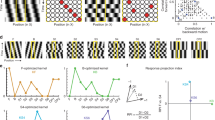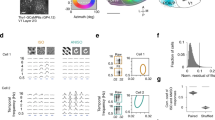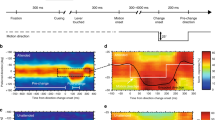Abstract
Stimulus discrimination depends on the selectivity and variability of neural responses, as well as the size and correlation structure of the responsive population. For direction discrimination in visual cortex, only the selectivity of neurons has been well characterized across development. Here we show in ferrets that at eye opening, the cortical response to visual stimulation exhibits several immaturities, including a high density of active neurons that display prominent wave-like activity, a high degree of variability and strong noise correlations. Over the next three weeks, the population response becomes increasingly sparse, wave-like activity disappears, and variability and noise correlations are markedly reduced. Similar changes were observed in identified neuronal populations imaged repeatedly over days. Furthermore, experience with a moving stimulus was capable of driving a reduction in noise correlations over a matter of hours. These changes in variability and correlation contribute significantly to a marked improvement in direction discriminability over development.
This is a preview of subscription content, access via your institution
Access options
Subscribe to this journal
Receive 12 print issues and online access
$209.00 per year
only $17.42 per issue
Buy this article
- Purchase on Springer Link
- Instant access to full article PDF
Prices may be subject to local taxes which are calculated during checkout








Similar content being viewed by others
References
Tomko, G.J. & Crapper, D.R. Neuronal variability: non-stationary responses to identical visual stimuli. Brain Res. 79, 405–418 (1974).
Tolhurst, D.J., Movshon, J.A. & Dean, A.F. The statistical reliability of signals in single neurons in cat and monkey visual cortex. Vision Res. 23, 775–785 (1983).
Tolhurst, D.J. The amount of information transmitted about contrast by neurones in the cat's visual cortex. Vis. Neurosci. 2, 409–413 (1989).
Willmore, B. & Tolhurst, D.J. Characterizing the sparseness of neural codes. Network 12, 255–270 (2001).
Yen, S.C., Baker, J. & Gray, C.M. Heterogeneity in the responses of adjacent neurons to natural stimuli in cat striate cortex. J. Neurophysiol. 97, 1326–1341 (2007).
Weliky, M., Fiser, J., Hunt, R.H., Wagner, D.N. & York, N. Coding of natural scenes in primary visual cortex. Neuron 37, 703–718 (2003).
Olshausen, B.A. & Field, D.J. Sparse coding of sensory inputs. Curr. Opin. Neurobiol. 14, 481–487 (2004).
Shadlen, M.N. & Newsome, W.T. Noise, neural codes and cortical organization. Curr. Opin. Neurobiol. 4, 569–579 (1994).
Abbott, L.F. & Dayan, P. The effect of correlated variability on the accuracy of a population code. Neural Comput. 11, 91–101 (1999).
Averbeck, B.B., Latham, P.E. & Pouget, A. Neural correlations, population coding and computation. Nat. Rev. Neurosci. 7, 358–366 (2006).
Chapman, B., Stryker, M.P. & Bonhoeffer, T. Development of orientation preference maps in ferret primary visual cortex. J. Neurosci. 16, 6443–6453 (1996).
Li, Y., Fitzpatrick, D. & White, L.E. The development of direction selectivity in ferret visual cortex requires early visual experience. Nat. Neurosci. 9, 676–681 (2006).
Chapman, B. & Stryker, M.P. Development of orientation selectivity in ferret visual cortex and effects of deprivation. J. Neurosci. 13, 5251–5262 (1993).
Krug, K., Akerman, C.J. & Thompson, I.D. Responses of neurons in neonatal cortex and thalamus to patterned visual stimulation through the naturally closed lids. J. Neurophysiol. 85, 1436–1443 (2001).
Rochefort, N.L. et al. Sparsification of neuronal activity in the visual cortex at eye-opening. Proc. Natl. Acad. Sci. USA 106, 15049–15054 (2009).
Ikezoe, K., Tamura, H., Kimura, F. & Fujita, I. Decorrelation of sensory-evoked neuronal responses in rat barrel cortex during postnatal development. Neurosci. Res. 73, 312–320 (2012).
Li, Y., Van Hooser, S.D., Mazurek, M., White, L.E. & Fitzpatrick, D. Experience with moving visual stimuli drives the early development of cortical direction selectivity. Nature 456, 952–956 (2008).
Derrington, A.M. & Fuchs, A.F. The development of spatial-frequency selectivity in kitten striate cortex. J. Physiol. (Lond.) 316, 1–10 (1981).
Berens, P. CircStat: a MATLAB toolbox for circular statistics. J. Stat. Softw. 31, 1–21 (2009).
Bair, W., Zohary, E. & Newsome, W.T. Correlated firing in macaque visual area MT: time scales and relationship to behavior. J. Neurosci. 21, 1676–1697 (2001).
Ecker, A.S. et al. Decorrelated neuronal firing in cortical microcircuits. Science 327, 584–587 (2010).
Smith, M.A. & Kohn, A. Spatial and temporal scales of neuronal correlation in primary visual cortex. J. Neurosci. 28, 12591–12603 (2008).
Clemens, J.M., Ritter, N.J., Roy, A., Miller, J.M. & Van Hooser, S.D. The laminar development of direction selectivity in ferret visual cortex. J. Neurosci. 32, 18177–18185 (2012).
Shadlen, M.N. & Newsome, W.T. The variable discharge of cortical neurons: implications for connectivity, computation, and information coding. J. Neurosci. 18, 3870–3896 (1998).
Kriener, B., Tetzlaff, T., Aertsen, A., Diesmann, M. & Rotter, S. Correlations and population dynamics in cortical networks. Neural Comput. 20, 2185–2226 (2008).
Van Hooser, S.D. et al. Initial neighborhood biases and the quality of motion stimulation jointly influence the rapid emergence of direction preference in visual cortex. J. Neurosci. 32, 7258–7266 (2012).
Jeanne, J.M., Sharpee, T.O. & Gentner, T.Q. Associative learning enhances population coding by inverting interneuronal correlation patterns. Neuron 78, 352–363 (2013).
Blankenship, A.G. & Feller, M.B. Mechanisms underlying spontaneous patterned activity in developing neural circuits. Nat. Rev. Neurosci. 11, 18–29 (2010).
Huberman, A.D., Feller, M.B. & Chapman, B. Mechanisms underlying development of visual maps and receptive fields. Annu. Rev. Neurosci. 31, 479–509 (2008).
Ackman, J.B. & Crair, M.C. Role of emergent neural activity in visual map development. Curr. Opin. Neurobiol. 24, 166–175 (2014).
Wu, J.Y., Xiaoying, H. & Chuan, Z. Propagating waves of activity in the neocortex: what they are, what they do. Neuroscientist 14, 487–502 (2008).
Sato, T.K., Nauhaus, I. & Carandini, M. Traveling waves in visual cortex. Neuron 75, 218–229 (2012).
Ackman, J.B., Burbridge, T.J. & Crair, M.C. Retinal waves coordinate patterned activity throughout the developing visual system. Nature 490, 219–225 (2012).
Siegel, F., Heimel, J.A., Peters, J. & Lohmann, C. Peripheral and central inputs shape network dynamics in the developing visual cortex in vivo. Curr. Biol. 22, 253–258 (2012).
Stroh, A. et al. Making waves: initiation and propagation of corticothalamic Ca2+ waves in vivo. Neuron 77, 1136–1150 (2013).
Wong, R.O., Meister, M. & Shatz, C.J. Transient period of correlated bursting activity during development of the mammalian retina. Neuron 11, 923–938 (1993).
Hanganu, I.L., Ben-Ari, Y. & Khazipov, R. Retinal waves trigger spindle bursts in the neonatal rat visual cortex. J. Neurosci. 26, 6728–6736 (2006).
Colonnese, M.T. et al. A conserved switch in sensory processing prepares developing neocortex for vision. Neuron 67, 480–498 (2010).
Ko, H. et al. Functional specificity of local synaptic connections in neocortical networks. Nature 473, 87–91 (2011).
Ko, H. et al. The emergence of functional microcircuits in visual cortex. Nature 496, 96–100 (2013).
Le Magueresse, C. & Monyer, H. GABAergic interneurons shape the functional maturation of the cortex. Neuron 77, 388–405 (2013).
Gao, W.J., Newman, D.E., Wormington, A.B. & Pallas, S.L. Development of inhibitory circuitry in visual and auditory cortex of postnatal ferrets: immunocytochemical localization of GABAergic neurons. J. Comp. Neurol. 409, 261–273 (1999).
Van Hooser, S.D., Escobar, G.M., Maffei, A. & Miller, P. Emerging feed-forward inhibition allows the robust formation of direction selectivity in the developing ferret visual cortex. J. Neurophysiol. 111, 2355–2373 (2014).
King, P.D., Zylberberg, J. & DeWeese, M.R. Inhibitory interneurons decorrelate excitatory cells to drive sparse code formation in a spiking model of V1. J. Neurosci. 33, 5475–5485 (2013).
Bernacchia, A. & Wang, X.J. Decorrelation by recurrent inhibition in heterogeneous neural circuits. Neural Comput. 25, 1732–1767 (2013).
Tetzlaff, T., Helias, M., Einevoll, G.T. & Diesmann, M. Decorrelation of neural-network activity by inhibitory feedback. PLOS Comput. Biol. 8, e1002596 (2012).
van Vreeswijk, C. & Sompolinsky, H. Chaotic balanced state in a model of cortical circuits. Neural Comput. 10, 1321–1371 (1998).
Renart, A. et al. The asynchronous state in cortical circuits. Science 327, 587–590 (2010).
Renart, A. & van Rossum, M.C. Transmission of population-coded information. Neural Comput. 24, 391–407 (2012).
Tian, L. et al. Imaging neural activity in worms, flies and mice with improved GCaMP calcium indicators. Nat. Methods 6, 875–881 (2009).
Brainard, D.H. The Psychophysics Toolbox. Spat. Vis. 10, 433–436 (1997).
Pelli, D.G. The VideoToolbox software for visual psychophysics: transforming numbers into movies. Spat. Vis. 10, 437–442 (1997).
Peirce, J.W. PsychoPy–Psychophysics software in Python. J. Neurosci. Methods 162, 8–13 (2007).
Ohki, K., Chung, S., Ch'ng, Y.H., Kara, P. & Reid, R.C. Functional imaging with cellular resolution reveals precise micro-architecture in visual cortex. Nature 433, 597–603 (2005).
Kara, P. & Boyd, J.D. A micro-architecture for binocular disparity and ocular dominance in visual cortex. Nature 458, 627–631 (2009).
Hendel, T. et al. Fluorescence changes of genetic calcium indicators and OGB-1 correlated with neural activity and calcium in vivo and in vitro. J. Neurosci. 28, 7399–7411 (2008).
Chen, T.W. et al. Ultrasensitive fluorescent proteins for imaging neuronal activity. Nature 499, 295–300 (2013).
Chen, L.M. et al. A chamber and artificial dura method for long-term optical imaging in the monkey. J. Neurosci. Methods 113, 41–49 (2002).
Averbeck, B.B. & Lee, D. Effects of noise correlations on information encoding and decoding. J. Neurophysiol. 95, 3633–3644 (2006).
Acknowledgements
We would like to thank D. Ouimet and V. Hoke for technical and surgical assistance, and R. Corlew for administrative support. This research was supported by US National Institutes of Health grants EY011488 (D.F.), EY022001 (G.B.S.), 5T32HG003284 (A.J.S.) and Bernstein Focus Neurotechnology grant 01GQ0840 (M.K.), as well as the Max Planck Florida Institute.
Author information
Authors and Affiliations
Contributions
G.B.S., A.S., M.K. and D.F. designed the study, analyzed the results and wrote the paper. G.B.S. performed the acute and longitudinal GCaMP imaging. Y.M.E. developed the method for longitudinal imaging. S.D.V.H. originally acquired the motion training data and prepared these data for the additional analyses reported here.
Corresponding authors
Ethics declarations
Competing interests
The authors declare no competing financial interests.
Integrated supplementary information
Supplementary Figure 1 Responses in identified neurons imaged repeatedly over days.
(a) Six representative neurons imaged on Day 0 (P30), Day 3 (P33), and Day 5 (P35). Scale bar is 50 µm. (b) Responses for individual neurons highlighted in a. Left column: Response to 8 directional stimuli, averaged across trials. Right column: Tuning curves fit with a 2-peaked Gaussian. Horizontal line indicates the mean response to a blank stimulus.
Supplementary Figure 2 Development of orientation and direction selective responses in identified neurons over days.
(a,c) Orientation preference is stable over days in longitudinally imaged animals. (b,d) Direction preference is stable in the majority of neurons, whereas a subset of cells exhibit 180 degree reversals. Red dashed lines indicate 180 degree shift from d0. (e) Orientation selectivity increases over days in identified neurons. Red dot indicates mean across neurons (s.e.m. error bars are smaller than marker). (f) DSI increases from the initial to final imaging session. Neurons with negative initial DSI (black symbols, mean indicated by green dot) reversed their direction preference over imaging sessions, but on average do not show an increase in selectivity. Neurons that maintain a preferred direction (positive initial DSI, blue symbols, mean indicated by red dot) exhibit significantly increased selectivity over days. Error bars indicating s.e.m. are smaller than markers for mean. Panels d & f are re-plotted from Figure 5 to facilitate comparison with orientation preference and selectivity.
Supplementary Figure 3 Evolution of noise correlation matrix and relative preferred direction over five days of development.
Cells are sorted by their preferred direction on the last day. (a-c): Noise correlation on day 0, day 3, and day 5. (d-f): Angular difference between cell pairs on day 0, day 3, and day 5. Correlations generally decrease from day 0 to day 5, with a prominent decrease in sets of cells sharing a preferred direction (cells 1 to 40).
Supplementary Figure 4 Initial noise correlations are higher for pairs that will ultimately adopt similar preferred directions.
(a) Cartoon depicting possible relationships in pairwise angular preference across imaging sessions, re-plotted from Figure 6. (b) Pairwise noise correlations during initial imaging as function of pairwise angular difference in preferred direction. Colored squares indicate regions of plot classified as S-S, S-O, O-O, and O-S, and quantified in Figure 6d,e.
Supplementary Figure 5 Possible scenarios for the maturation of direction discriminability.
(a) Possible scenarios for the maturation of single cell discriminability. Stimuli to be discriminated are moving gratings with opposite directions of motion. Early cortex (left): Response distribution of a single cell for a left moving grating (blue) and a right moving grating (red). Mean responses are indicated by vertical lines. Direction selectivity is commonly defined as the difference of mean responses divided by their sum. Single trial discriminability of motion direction critically depends on the fraction of overlap between the two distributions. If the overlap is close to 100%, discriminability is close to 0. If the overlap is small, discriminability is close to 1. During development, discriminability can improve by shifting the mean responses apart, i.e. by increasing the cell’s direction selectivity (right, upper). However, discriminability can also improve by reducing the response variance (without changing the selectivity; right, lower). (b) Possible scenarios for the maturation of multi-cell discriminability, here for a population of two neurons. Early cortex (left): Response distribution for a left (blue) and a right moving grating (red). Assuming response fluctuations follow a Gaussian statistics, the bivariate distributions have elliptic shapes (marking the 95% confidence region for the response distributions). Mean response vectors are marked by dots. In the shown example both cells are tuned for the same stimulus direction and their noise correlation is positive. As in the single cell case, discriminability depends on the fraction of overlap between the two distributions. This fractional overlap can decrease over development as cells become more selective (right, upper), as the overall magnitude of fluctuations decreases (right, middle) or as noise correlations become smaller (right, lower).
Supplementary Figure 6 Individual neurons increase discriminability despite reduced selectivity due to decreased variability.
(a) Discriminability increases significantly over days in identified neurons. (b) The majority of neurons exhibit increased discriminability over days (light blue). These neurons are analyzed further in panels c-i. (c) Of the neurons exhibiting increased discriminability over days, the majority also display increased direction selectivity (HS cells, red), whereas a subset show decreased selectivity over days (LS cells, blue). (d) In LS cells, neither the preferred nor the null response changes significantly. (e) HS neurons achieve enhanced selectivity both through an increase in the preferred response and a decrease in the null response. (f) Variability decreases significantly for both LS and HS groups, however variability decreases to a greater extent in cells without increased selectivity (blue) than in those where selectivity increases (red). (g) For LS cells, only the change in variance contributes positively to the increase in discriminability. (h) For HS cells, both the decreased variance and the increased selectivity contribute significantly to increased discriminability, with the change in mean response providing a significantly greater contribution. (i) Changes in variance provide a significantly greater contribution to improved discriminability in LS vs. HS neurons.
Supplementary Figure 7 Noise correlations decrease asymmetrically in longitudinally imaged animals.
Correlations decrease over imaging sessions to a larger extent in S-S vs. S-O pairs. Likewise, the decrease in correlations is larger in O-S vs. O-O pairs. Change in correlations are normalized within animal to the change exhibited by S-S pairs. (*) indicates MW test, p<0.01. Error bars indicate s.e.m.
Supplementary Figure 8 Change in response variance vs. change in selectivity.
(a) Distribution of standard deviation of response to preferred stimulus for all cells, pre- and post-training. Variance of response does not change significantly over motion training. (b) Response variance is calculated across the preferred orientation before and after training. Each point represents the average change for a single field of view. (c) Overall change in standard deviation for each training type. (d) Same as (b), but for the orientation orthogonal to the preferred orientation. (e) Same as (c), but for the orthogonal orientation. Error bars represent +/- 1 SEM.
Supplementary Figure 9 Single neuron response distributions across age groups.
Distribution of activity levels over all stimulus conditions with stimulus means subtracted (see Eqn. 8, 9, Methods) for 10 representative and randomly selected cells from the naive (a), immature (b), and mature (c) populations of cells.
Supplementary information
Supplementary Text and Figures
Supplementary Figures 1–9 and Supplementary Tables 1–6 (PDF 5740 kb)
Supplementary Video 1: Wave-like responses to drifting grating stimuli at eye opening.
Response to two presentations of drifting grating stimuli with the same orientation, drifting in opposite directions. Movie is shown at 2x real-time. Stimulus presentation and direction are indicated by arrow in upper left. Scale bar is 50 μm. 512 × 256 images with a 1:2 aspect ratio were acquired at 60 Hz, downsampled to 15 Hz and resized to 512 × 512 by bilinear interpolation. Images were then filtered in x-y by a 2×2 pixel radius mean filter, Z-scored relative to the mean and standard deviation of the blank stimulus, and clipped at 0 to 4 Z-units. (AVI 28536 kb)
Rights and permissions
About this article
Cite this article
Smith, G., Sederberg, A., Elyada, Y. et al. The development of cortical circuits for motion discrimination. Nat Neurosci 18, 252–261 (2015). https://doi.org/10.1038/nn.3921
Received:
Accepted:
Published:
Issue Date:
DOI: https://doi.org/10.1038/nn.3921
This article is cited by
-
Three-photon imaging of synthetic dyes in deep layers of the neocortex
Scientific Reports (2020)
-
An early phase of instructive plasticity before the typical onset of sensory experience
Nature Communications (2020)
-
Does experience provide a permissive or instructive influence on the development of direction selectivity in visual cortex?
Neural Development (2018)
-
High-yield in vitro recordings from neurons functionally characterized in vivo
Nature Protocols (2018)
-
Distributed network interactions and their emergence in developing neocortex
Nature Neuroscience (2018)



